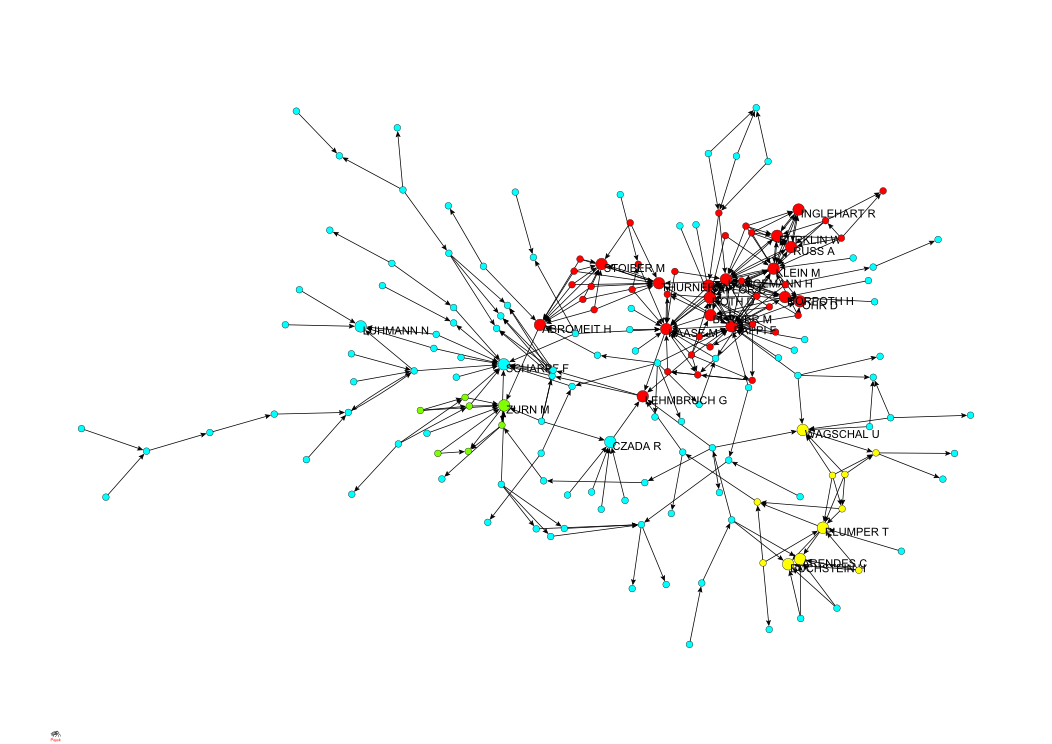Citations in Politische Vierteljahresschrift (PVS)
Patterns of Citations in German Political Science
Slightly more than 40 per cent (240) of the 594 authors publishing in PVS cite other articles that have appeared in the journal. From this figure alone, it is clear that the authors of PVS are not a close-knit group (or if they are, this does not manifest itself in citations within the journal). Slightly less than 10 per cent (26) of the authors cite their own work in PVS.
Indegree as the most straightforward measure of scientific authority or reputation within this network varies wildly. 46 per cent of all authors are not cited by anyone else, 22 per cent receive a citation from a single author, and 18 per cent are cited 2 to 4 other authors. 24 authors (16 per cent), however, receive between 5 and 21 citations. On the very top of this hierarchy, we find Scharpf, Klein, Klingemann, Kaase, and Pappi, who are cited by 13, 14, 17, 18, and 21 different scholars respectively. Again, its interesting to note that these top 5 authors are all involved in empirical work.
There is very little evidence for the existence of citation circles, although again we must keep in mind that very few authors have the chance to publish more than one article in PVS. The largest structure involves 12 authors (amongst them Klein, Klingemann and Pappi). The majority of them was based at the University of Mannheim at some time.
However, mutual citations are a relatively restrictive criterion. We therefore split the network into weak components. 70 per cent (171) authors are within the largest component. To further split this component into dense subgroups which are akin to subfields, we employ the concept of triangular connectivity, i.e. we count the number of 3-rings (both cyclic and transitive) in which each arc between two authors is contained. This count assigns large weights to arcs which are part of a "clique". Crucially, this notion of triangular connectivity is more inclusive than indegree and mutual citations: authors who do not (yet) receive citations but do themselves cite other authors in the subfield are not excluded per default. In the next step, we apply the "island" algorithm implemented in Pajek to the network to identify cohesive clusters (with a minimum size of 5 and a maximum size of n-1).

This elicits three potential subfields. A first group with Zurn at its centre consists of IR scholars who share a particular interest in the European Union and the notion of (multi-level) governance. A second group of 11 scholars is more disparate and constituted by the work of a single scholar (Plümper), who has published five articles different genres.
The largest and most coherent cluster is formed by 47 authors working in the subfield of empirical political sociology, broadly defined. The size and density of this network might be slightly exaggerated by the fact that these authors tend to co-publish so that a citation of a multi-authored paper in another multi-authored paper generates a lot of lines, even if self-cites are deleted. Nonetheless, there can be little doubt that this is the densest region of the PVS citation network, which contains four of the journal's most central and prolific scholars (Kaase, Klein, Klingemann, and Pappi). If it does make any sense at all to treat the authors of PVS as a community, this would be its core.